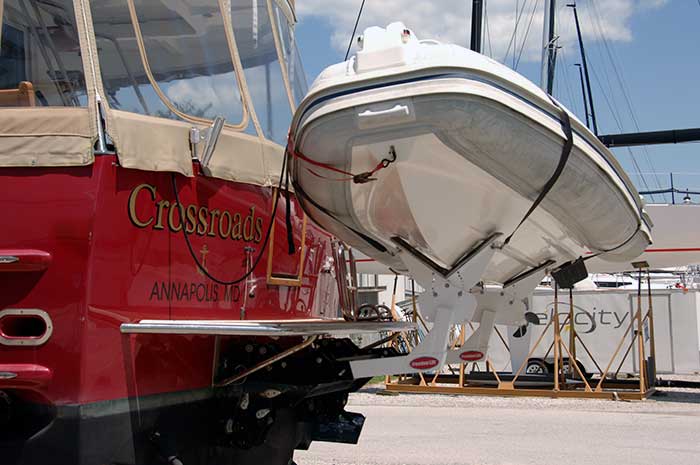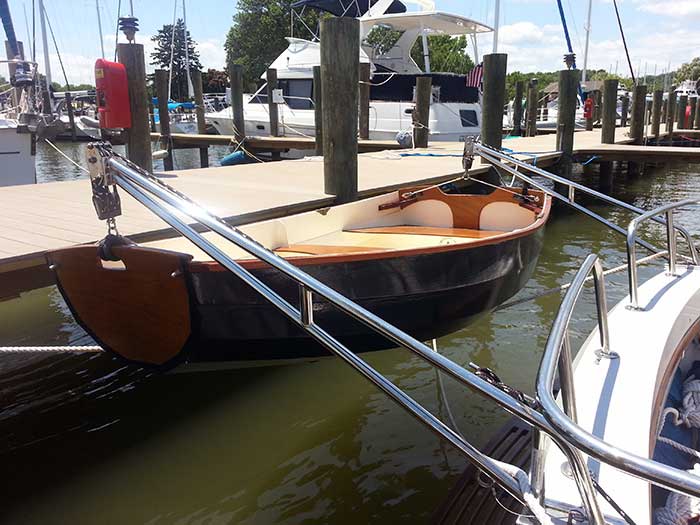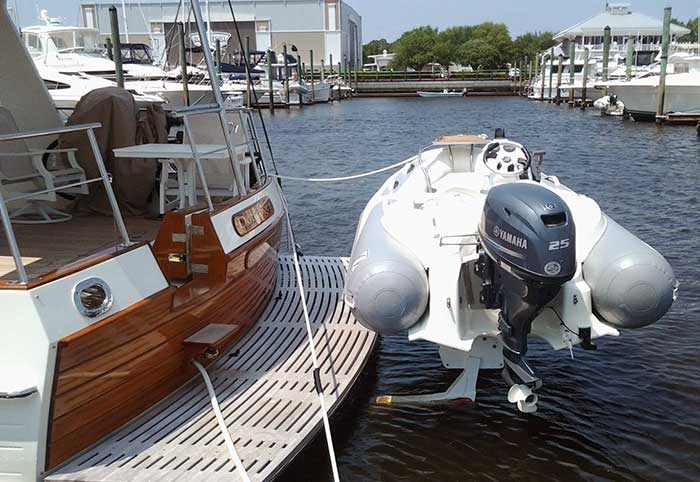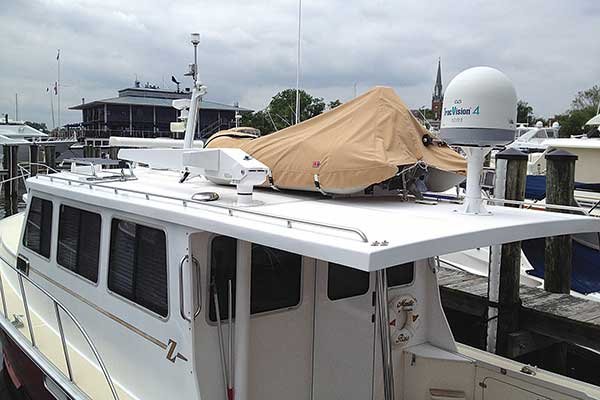Advertisement
If dinghy storage is lacking on your boat, the wide range of davits now available can offer a solution.

Photo: Bill Parlatore
When a boat is large enough for even the occasional overnight, the need for a dinghy becomes almost mandatory. But where do you put that all-important link to shore for lunch, dinner, shopping for supplies, walking the dog, seeing the sights, exploring the shoreline, or visiting neighboring boats? Fortunately, when it comes to davits, we have many choices to suit needs and budgets. Considering the variables when comparing davit systems, and finding the best system may take some research, but there are solutions to fit every boat. The goal is to find the one that works best for your boat and makes your day on the water easy and fun.
Whether you have an express cruiser, trawler, sport cruiser, picnic boat, or other style of craft, before you jump in, make a realistic assessment of your dinghy because its size, weight, and that of its outboard will have a significant impact on davit choices. While a large rigid inflatable boat (RIB) with a 50-hp outboard might be great fun on the family vacation, there are likely serious limitations for a davit system to fit such a boat. Dinghy size and weight may impact trim, performance, and the structural integrity of your mother ship. While some boat owners get around this by towing their large dinghy, it's not a safe or practical solution for anything more than a short hop from one anchorage to another. TowBoatUS and the BoatUS Marine Insurance Program get dozens of calls each year after a towed dinghy has done damage to itself or the boat towing it.
Keith Olver of davit manufacturer KATO Marine says the question of what dinghy you want comes with an important caveat. "It's harder for us to design for what owners want, rather than selecting a dinghy for what is possible." If you've already got a dinghy, you may be able to build a system to fit it. If not, the next step is to find a system that works for your boat type, knowing that the system you choose will box in the size and weight of the dinghy.
Tip
Traditional Davit Arms
Davit arms work best on boats with vertical transoms or sterns with railings strong enough to be the basis of support for the davit arms, such as a lobster boat or trawler-style cruiser. The arms mount onto the top of the transom and extend out behind the boat, clearing the swim platform, if there is one. Additional bracing of the transom area is sometimes required to reinforce the hull from the shock loading of a bouncing dinghy in rough weather.

Traditional davit arms offer a reliable solution, but the dinghy does block access to the swim platform. (Photo: Joe Marin)
Weight is important when planning a traditional davit-hanging system. Selecting a pair of davit arms each rated for a maximum of 300 pounds doesn't mean it's safe to carry a 600-pound dinghy. Up to 75 percent of the total weight of the dinghy and outboard is in the stern. So one davit arm will always be loaded much more heavily than the other and may need to be reinforced if there's any question of its ultimate integrity.
Other configurations attach the davit arms directly to the stern rail with additional bracing to strengthen the railing support. Olver says it's essential to strengthen the stern rail to handle the increased weight of the dinghy hanging from the davit. It's also important to stabilize the davit arms so they can't move from side to side as the boat moves. This lateral support is often done by connecting the davit arms with rigid support between the two.
The dinghy must be stabilized to prevent motion when stored. The weight of gravity pulling the dinghy down becomes a compound set of forces when the boat is moving, and every effort must be made to steady and eliminate all movement. Most davit systems that fail do so because the dinghy was allowed to swing underway, or it comes loose, and the combination of side-to-side and up-and-down movements creates complex loads beyond the engineered capacity of the davit system. The twin-davit-arm system is a proven approach for handling the dinghy and has much to recommend it. Some companies offer removable arms that can be taken off and stowed when necessary, such as those from St. Croix Marine.
Swing-Up/Snap Davits
Another system that's been around for a long time was pioneered by Weaver Industries. Called the Weaver Snap Davits, the system involves attaching connecting hardware to both the dinghy and swim platform. The dinghy fittings snap into those on the swim platform and you pull the dinghy up vertically onto the swim platform, either manually or electrically, and secure it in a near-vertical position with standoff brackets or ties. St. Croix Marine Products and Sea Wise Marine are manufacturers of similar systems, and an optional hydraulic operation is even offered.

Swing-up or snap davits are easy to install yourself, and work best with light inflatables powered by small outboards.
Most dinghy installations require the removal of the outboard engine from the dinghy, although these companies have optional equipment that can be added to allow the outboard to remain on the dinghy and swivel as the dinghy swings up. Using a smaller and lighter outboard might make sense for this system if you intend to remove the engine each time the dinghy is secured.
Snap davits are popular with owners of smaller boats that have a swim platform, or on boats with large cockpits, such as the picnic-style powerboat or express cruiser, where it's about the only way to carry a dinghy. These are generally good do-it-yourself install projects and relatively inexpensive.
As popular as these swing-up systems are, I find it frustrating to overtake a boat when its dinghy is carried vertically on the swim platform, covering the boat's name and hailing port and making that VHF call for a portside pass challenging. Some boat owners paint the boat's name on the bottom of the dinghy for this reason. Rear visibility from some helms can be an issue when the dinghy is vertical on the swim platform, and, of course, using the swim platform is harder when a dinghy is stored on it. If you choose one of these systems, make sure the dinghy will not obscure your stern light when stowed.
Pull-Up, Slide-Up Davits
These davit systems offer a low-tech approach to handling the dinghy. The pull- or slide-up davits have two hinged cradle arms mounted onto the swim platform. When you want to get the dinghy aboard, the hinged arms tilt out to the water from the swim platform, and you pull the dinghy sideways onto the cradle arms.

Pull- or slide-up davits work best on boats with wider swim platforms, and allow you to leave the outboard in place.
As the center of weight comes aboard, the hinged arms come back to rest on the swim platform and the dinghy is then secured with straps on the swim platform. The outboard doesn't have to be removed. These davits can be used on most swim platforms wider than 18 inches and work best if the top of the swim platform is relatively close to the water. If the platform is too high, it can be difficult to manually pull a dinghy aboard. An electric winch can be used to accomplish this on some vessels.
Lifting Platforms
I recently spoke with Steve Wallace, manager of Zimmerman Marine at Southport Marina n North Carolina. His facility is located along the Intracoastal Waterway in a town that is a safe haven from the ocean, giving Steve the opportunity to talk to many hundreds of cruisers passing through Southport. "The key to happiness is ease of use," Steve said. "Boaters want to push a button and just go."

Hydraulic lifting arms and platforms are convenient but expensive.
Hydraulic and electric platforms with cradles have really come into their own in the last decade, especially with electronic controls and refined engineering. The concept of a lifting swim platform or cradle really resonates with powerboat owners no longer wanting traditional block-and-tackle systems. These hydraulic lifts can handle much greater weight, and you can opt for some form of sport boat instead of a traditional inflatable dinghy, while retaining easy launch and retrieve capability using a remote. As you might imagine, installing a lifting swim platform is best done during construction. One can be added as an aftermarket project, but it depends on the boat. That is perhaps why more builders offer a lifting swim platform as an option on a new boat when access is best before steering, exhaust, and machinery systems go in.
Lifting Cranes
If the cost of a lifting platform is beyond reach, or it can't easily be retrofitted to an existing boat, a lifting crane may be an option, using hydraulic, electric, pneumatic, or manual power.

Lifting cranes can help you store your dinghy up on the flybridge or hardtop out of the way, reducing the chance of theft or damage, but usually require significant structural reinforcement during installation.
A standpipe is installed in the boat, firmly attached to the hull and deck structure, and a telescoping crane fits into it. The crane lifts the dinghy off its cradle, and the boom swings out over the side of the boat to lower the dinghy into the water. Lifting cranes used to be seen only on very large yachts, but now they can be found on boats under 40 feet.
